ARTS220: Comparing Sikh Marriages in India and New Zealand
VerifiedAdded on 2022/09/14
|20
|5675
|18
Essay
AI Summary
This essay provides a comparative analysis of Sikh marriages, examining their sociocultural aspects in both India and New Zealand. It begins by defining key terms and establishing the significance of marriage within the field of anthropology. The paper explores the concept of marriage through the lenses of universalism and cultural diversity, highlighting how Sikh marriages have evolved in response to different social and cultural contexts. It then delves into the social and cultural facets of Sikh weddings, comparing traditional practices in India with those observed in New Zealand, with an ethnographic perspective. The research methodology involves a qualitative approach, incorporating participant-observation and a review of scholarly literature. The essay considers the impact of migration and acculturation on Sikh marriage traditions, including the influence of societal changes in both regions. The paper also addresses the challenges faced by the Sikh community in New Zealand, such as racism and cultural misunderstandings. The conclusion synthesizes the findings, reflecting on the transformations in Sikh marriage customs and their adaptation to diverse environments, while adhering to the principles of sociocultural anthropology. The essay also includes a reflection on the author's personal experience of a Sikh wedding in New Zealand.
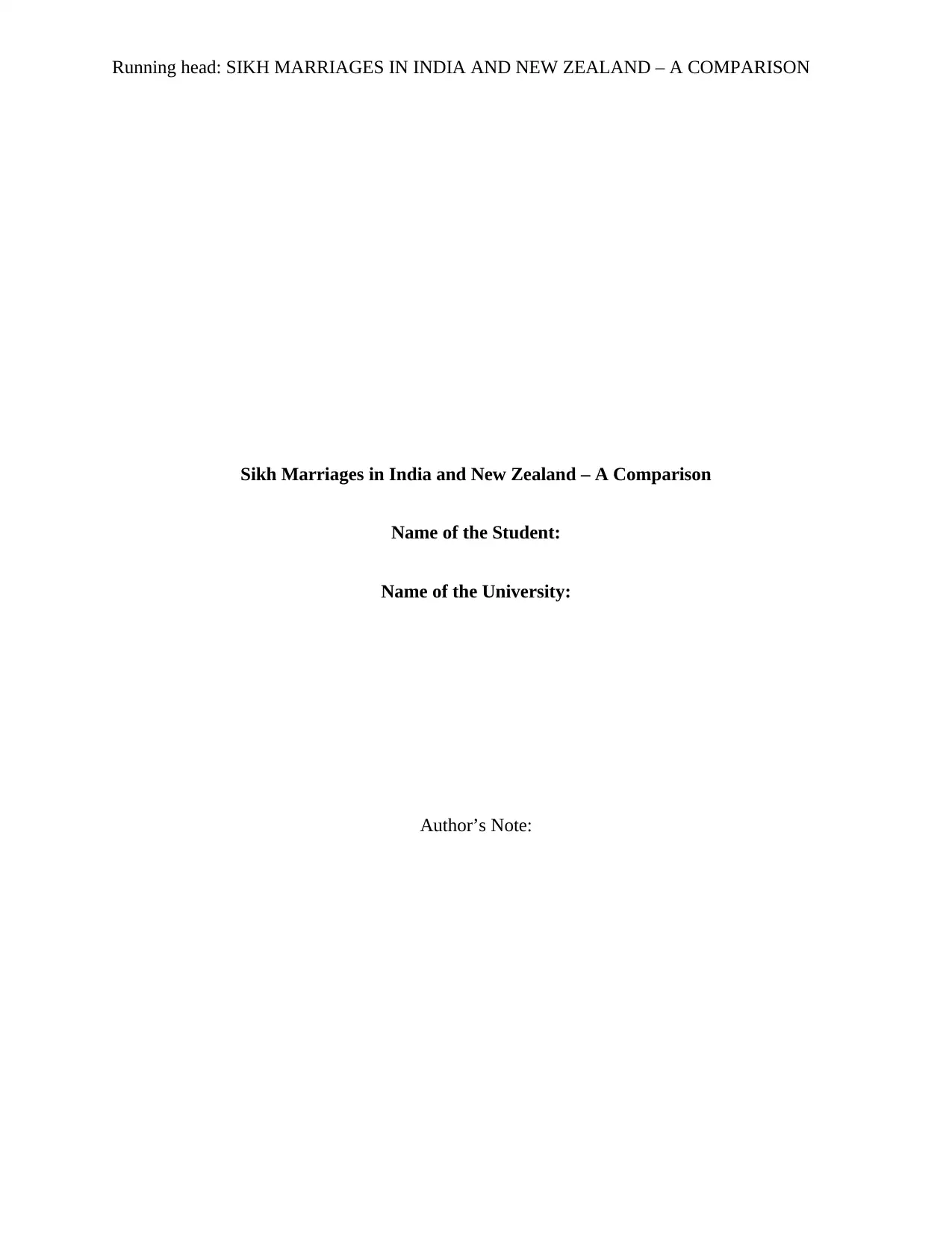
Running head: SIKH MARRIAGES IN INDIA AND NEW ZEALAND – A COMPARISON
Sikh Marriages in India and New Zealand – A Comparison
Name of the Student:
Name of the University:
Author’s Note:
Sikh Marriages in India and New Zealand – A Comparison
Name of the Student:
Name of the University:
Author’s Note:
Paraphrase This Document
Need a fresh take? Get an instant paraphrase of this document with our AI Paraphraser
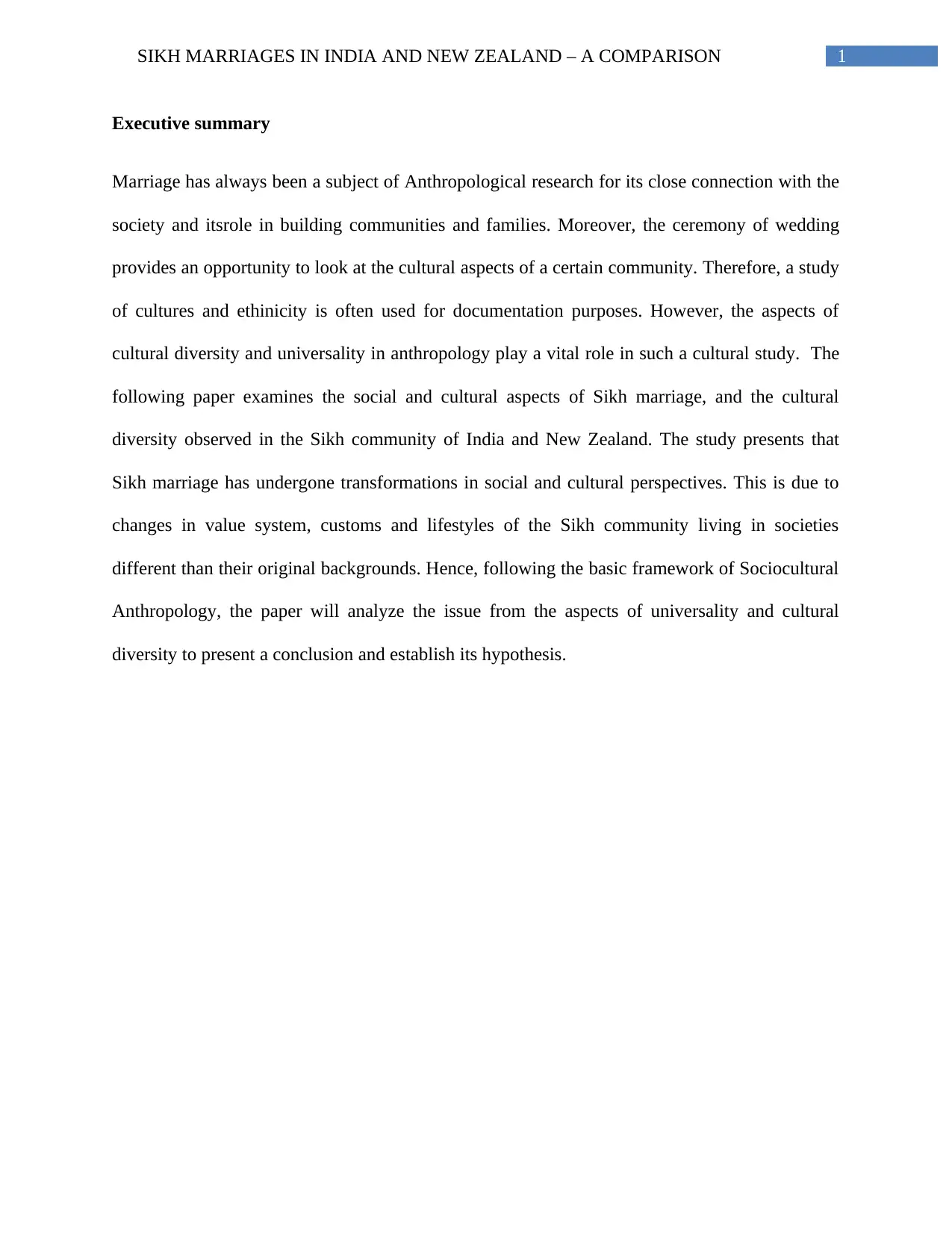
1SIKH MARRIAGES IN INDIA AND NEW ZEALAND – A COMPARISON
Executive summary
Marriage has always been a subject of Anthropological research for its close connection with the
society and itsrole in building communities and families. Moreover, the ceremony of wedding
provides an opportunity to look at the cultural aspects of a certain community. Therefore, a study
of cultures and ethinicity is often used for documentation purposes. However, the aspects of
cultural diversity and universality in anthropology play a vital role in such a cultural study. The
following paper examines the social and cultural aspects of Sikh marriage, and the cultural
diversity observed in the Sikh community of India and New Zealand. The study presents that
Sikh marriage has undergone transformations in social and cultural perspectives. This is due to
changes in value system, customs and lifestyles of the Sikh community living in societies
different than their original backgrounds. Hence, following the basic framework of Sociocultural
Anthropology, the paper will analyze the issue from the aspects of universality and cultural
diversity to present a conclusion and establish its hypothesis.
Executive summary
Marriage has always been a subject of Anthropological research for its close connection with the
society and itsrole in building communities and families. Moreover, the ceremony of wedding
provides an opportunity to look at the cultural aspects of a certain community. Therefore, a study
of cultures and ethinicity is often used for documentation purposes. However, the aspects of
cultural diversity and universality in anthropology play a vital role in such a cultural study. The
following paper examines the social and cultural aspects of Sikh marriage, and the cultural
diversity observed in the Sikh community of India and New Zealand. The study presents that
Sikh marriage has undergone transformations in social and cultural perspectives. This is due to
changes in value system, customs and lifestyles of the Sikh community living in societies
different than their original backgrounds. Hence, following the basic framework of Sociocultural
Anthropology, the paper will analyze the issue from the aspects of universality and cultural
diversity to present a conclusion and establish its hypothesis.
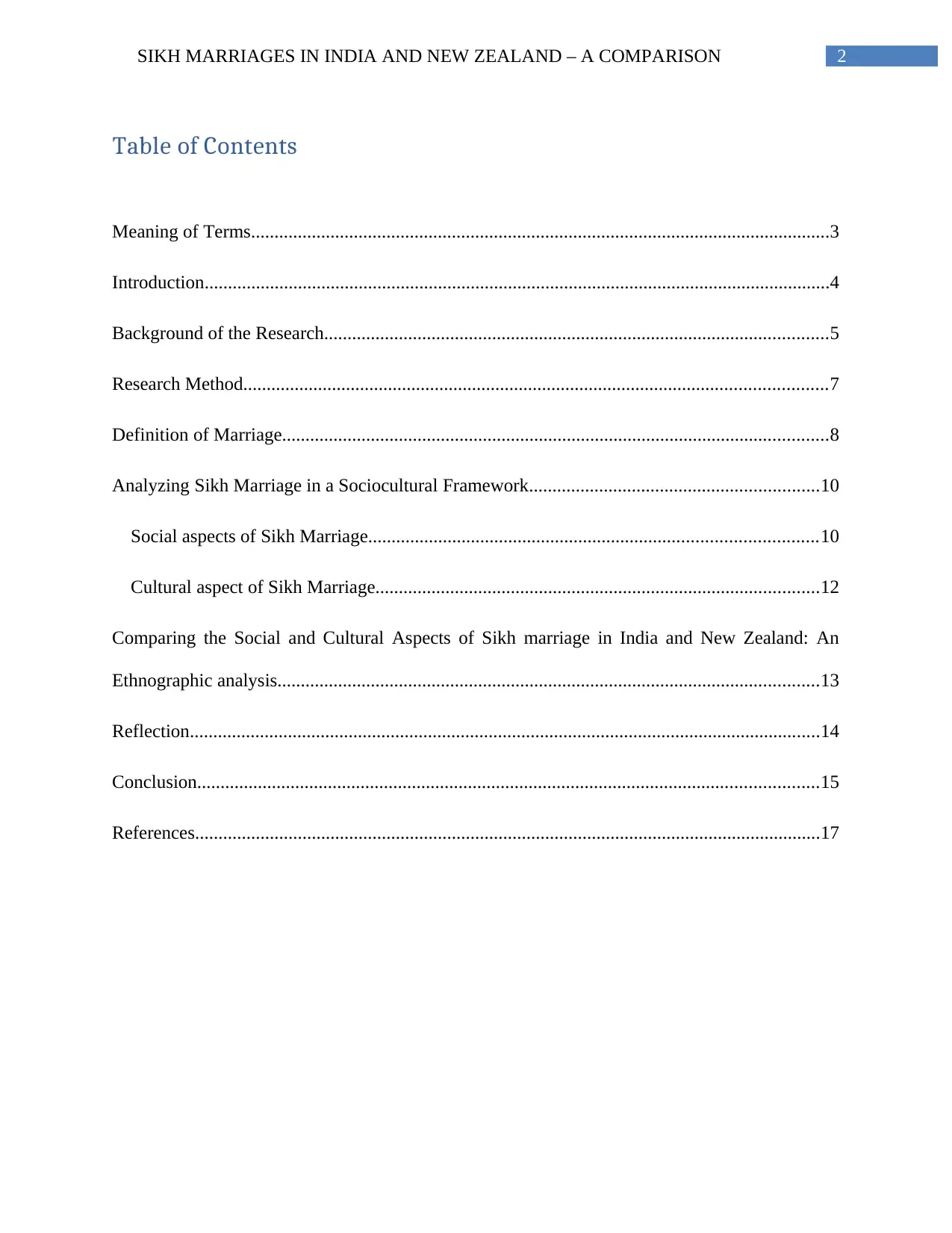
2SIKH MARRIAGES IN INDIA AND NEW ZEALAND – A COMPARISON
Table of Contents
Meaning of Terms............................................................................................................................3
Introduction......................................................................................................................................4
Background of the Research............................................................................................................5
Research Method.............................................................................................................................7
Definition of Marriage.....................................................................................................................8
Analyzing Sikh Marriage in a Sociocultural Framework..............................................................10
Social aspects of Sikh Marriage................................................................................................10
Cultural aspect of Sikh Marriage...............................................................................................12
Comparing the Social and Cultural Aspects of Sikh marriage in India and New Zealand: An
Ethnographic analysis....................................................................................................................13
Reflection.......................................................................................................................................14
Conclusion.....................................................................................................................................15
References......................................................................................................................................17
Table of Contents
Meaning of Terms............................................................................................................................3
Introduction......................................................................................................................................4
Background of the Research............................................................................................................5
Research Method.............................................................................................................................7
Definition of Marriage.....................................................................................................................8
Analyzing Sikh Marriage in a Sociocultural Framework..............................................................10
Social aspects of Sikh Marriage................................................................................................10
Cultural aspect of Sikh Marriage...............................................................................................12
Comparing the Social and Cultural Aspects of Sikh marriage in India and New Zealand: An
Ethnographic analysis....................................................................................................................13
Reflection.......................................................................................................................................14
Conclusion.....................................................................................................................................15
References......................................................................................................................................17
⊘ This is a preview!⊘
Do you want full access?
Subscribe today to unlock all pages.

Trusted by 1+ million students worldwide
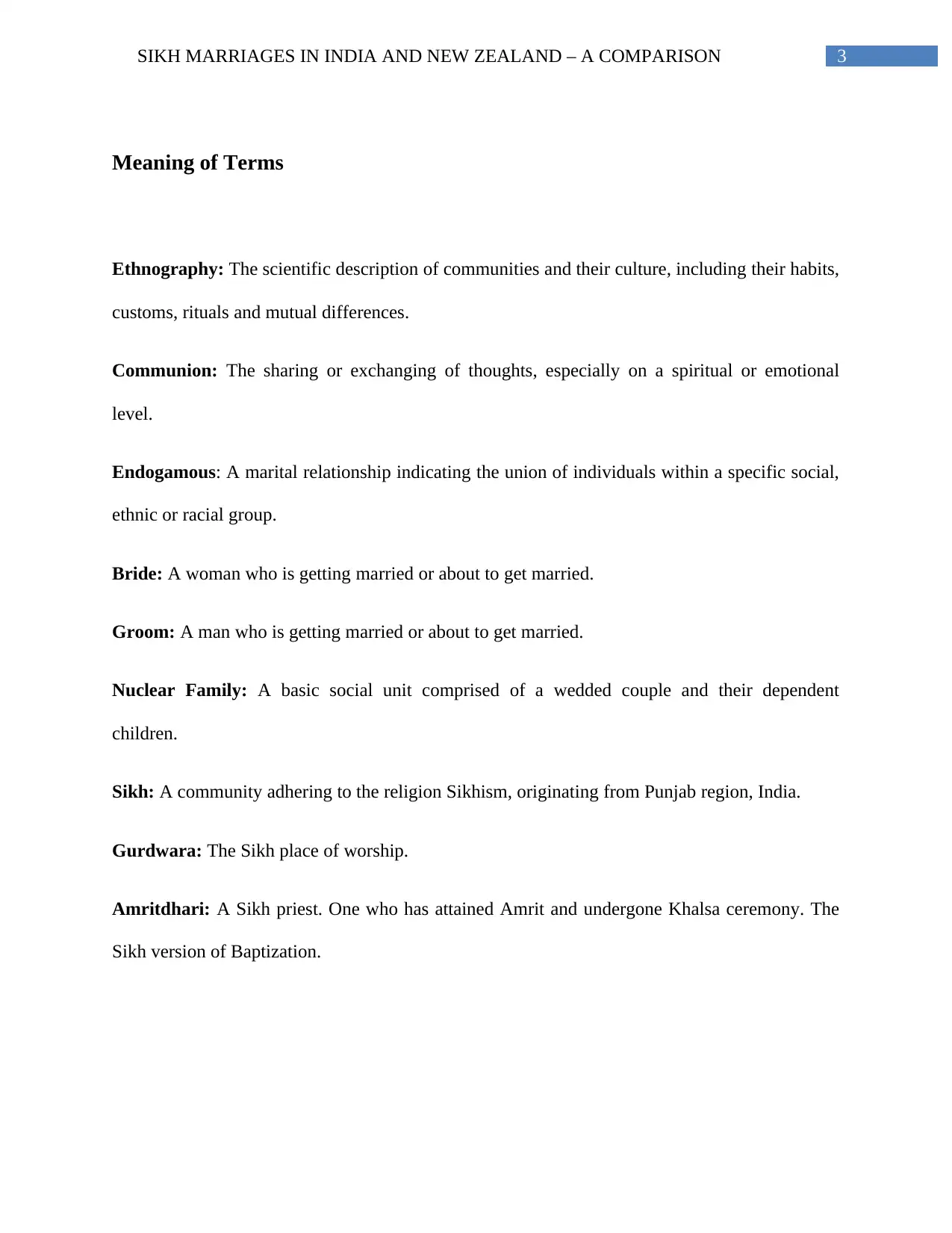
3SIKH MARRIAGES IN INDIA AND NEW ZEALAND – A COMPARISON
Meaning of Terms
Ethnography: The scientific description of communities and their culture, including their habits,
customs, rituals and mutual differences.
Communion: The sharing or exchanging of thoughts, especially on a spiritual or emotional
level.
Endogamous: A marital relationship indicating the union of individuals within a specific social,
ethnic or racial group.
Bride: A woman who is getting married or about to get married.
Groom: A man who is getting married or about to get married.
Nuclear Family: A basic social unit comprised of a wedded couple and their dependent
children.
Sikh: A community adhering to the religion Sikhism, originating from Punjab region, India.
Gurdwara: The Sikh place of worship.
Amritdhari: A Sikh priest. One who has attained Amrit and undergone Khalsa ceremony. The
Sikh version of Baptization.
Meaning of Terms
Ethnography: The scientific description of communities and their culture, including their habits,
customs, rituals and mutual differences.
Communion: The sharing or exchanging of thoughts, especially on a spiritual or emotional
level.
Endogamous: A marital relationship indicating the union of individuals within a specific social,
ethnic or racial group.
Bride: A woman who is getting married or about to get married.
Groom: A man who is getting married or about to get married.
Nuclear Family: A basic social unit comprised of a wedded couple and their dependent
children.
Sikh: A community adhering to the religion Sikhism, originating from Punjab region, India.
Gurdwara: The Sikh place of worship.
Amritdhari: A Sikh priest. One who has attained Amrit and undergone Khalsa ceremony. The
Sikh version of Baptization.
Paraphrase This Document
Need a fresh take? Get an instant paraphrase of this document with our AI Paraphraser
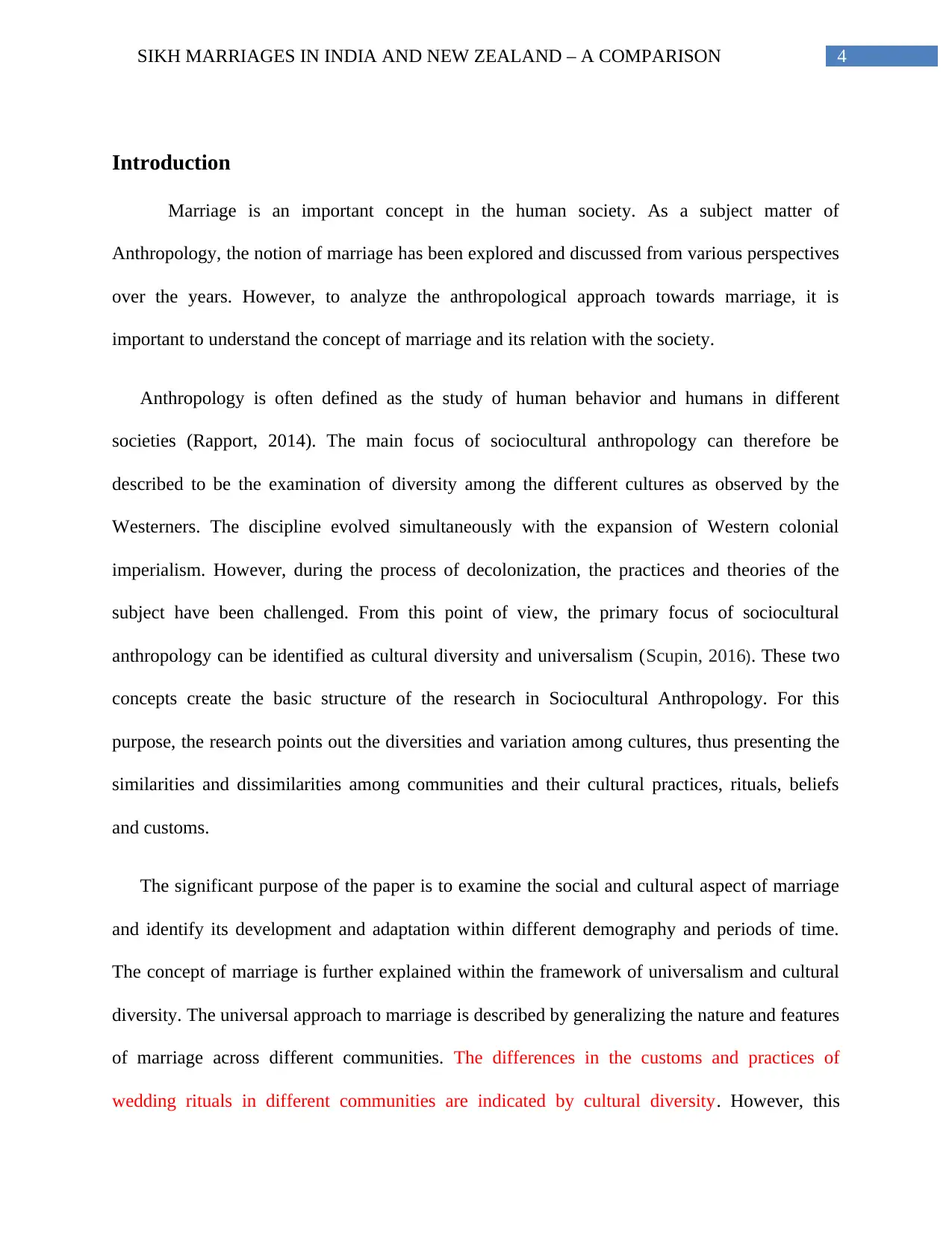
4SIKH MARRIAGES IN INDIA AND NEW ZEALAND – A COMPARISON
Introduction
Marriage is an important concept in the human society. As a subject matter of
Anthropology, the notion of marriage has been explored and discussed from various perspectives
over the years. However, to analyze the anthropological approach towards marriage, it is
important to understand the concept of marriage and its relation with the society.
Anthropology is often defined as the study of human behavior and humans in different
societies (Rapport, 2014). The main focus of sociocultural anthropology can therefore be
described to be the examination of diversity among the different cultures as observed by the
Westerners. The discipline evolved simultaneously with the expansion of Western colonial
imperialism. However, during the process of decolonization, the practices and theories of the
subject have been challenged. From this point of view, the primary focus of sociocultural
anthropology can be identified as cultural diversity and universalism (Scupin, 2016). These two
concepts create the basic structure of the research in Sociocultural Anthropology. For this
purpose, the research points out the diversities and variation among cultures, thus presenting the
similarities and dissimilarities among communities and their cultural practices, rituals, beliefs
and customs.
The significant purpose of the paper is to examine the social and cultural aspect of marriage
and identify its development and adaptation within different demography and periods of time.
The concept of marriage is further explained within the framework of universalism and cultural
diversity. The universal approach to marriage is described by generalizing the nature and features
of marriage across different communities. The differences in the customs and practices of
wedding rituals in different communities are indicated by cultural diversity. However, this
Introduction
Marriage is an important concept in the human society. As a subject matter of
Anthropology, the notion of marriage has been explored and discussed from various perspectives
over the years. However, to analyze the anthropological approach towards marriage, it is
important to understand the concept of marriage and its relation with the society.
Anthropology is often defined as the study of human behavior and humans in different
societies (Rapport, 2014). The main focus of sociocultural anthropology can therefore be
described to be the examination of diversity among the different cultures as observed by the
Westerners. The discipline evolved simultaneously with the expansion of Western colonial
imperialism. However, during the process of decolonization, the practices and theories of the
subject have been challenged. From this point of view, the primary focus of sociocultural
anthropology can be identified as cultural diversity and universalism (Scupin, 2016). These two
concepts create the basic structure of the research in Sociocultural Anthropology. For this
purpose, the research points out the diversities and variation among cultures, thus presenting the
similarities and dissimilarities among communities and their cultural practices, rituals, beliefs
and customs.
The significant purpose of the paper is to examine the social and cultural aspect of marriage
and identify its development and adaptation within different demography and periods of time.
The concept of marriage is further explained within the framework of universalism and cultural
diversity. The universal approach to marriage is described by generalizing the nature and features
of marriage across different communities. The differences in the customs and practices of
wedding rituals in different communities are indicated by cultural diversity. However, this
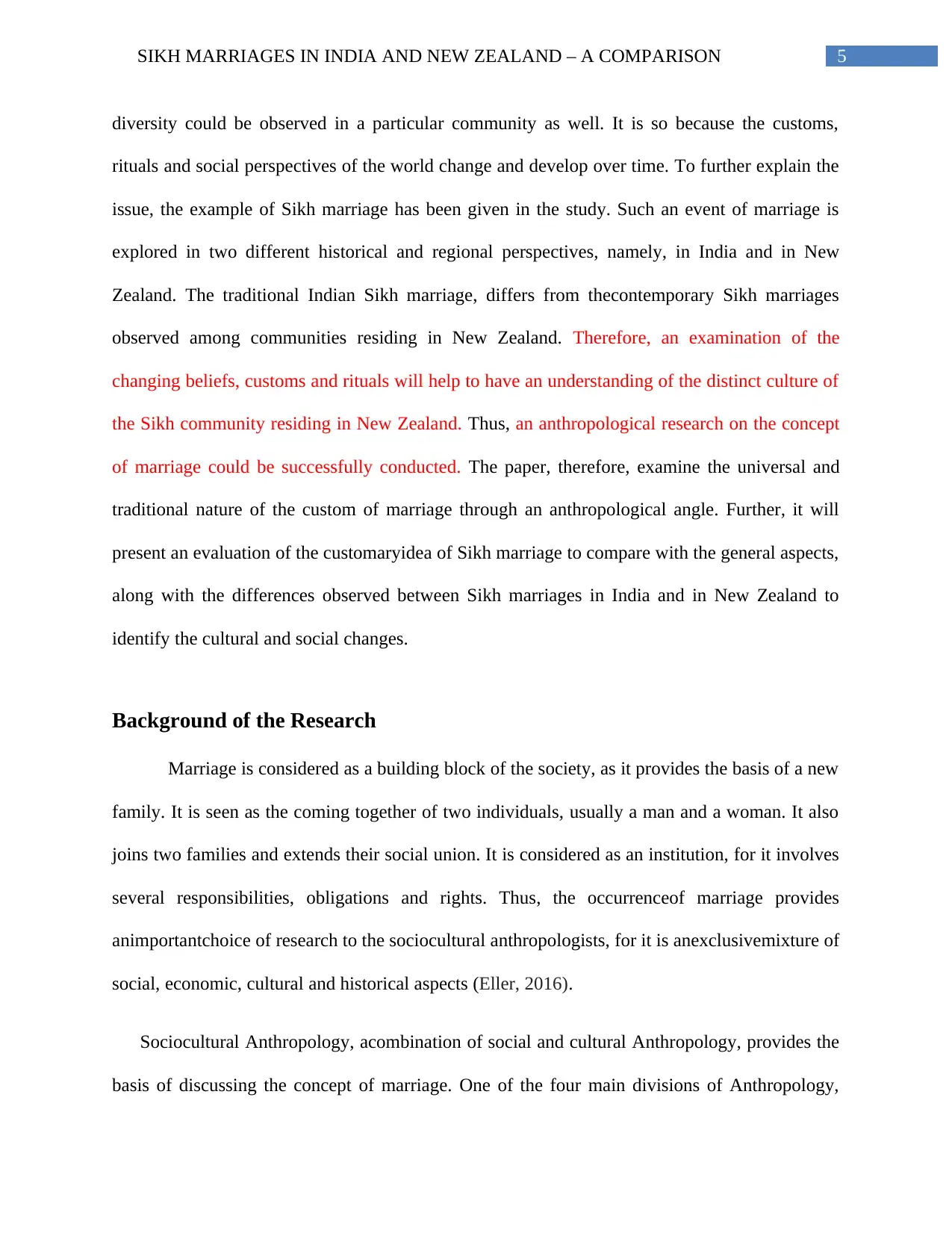
5SIKH MARRIAGES IN INDIA AND NEW ZEALAND – A COMPARISON
diversity could be observed in a particular community as well. It is so because the customs,
rituals and social perspectives of the world change and develop over time. To further explain the
issue, the example of Sikh marriage has been given in the study. Such an event of marriage is
explored in two different historical and regional perspectives, namely, in India and in New
Zealand. The traditional Indian Sikh marriage, differs from thecontemporary Sikh marriages
observed among communities residing in New Zealand. Therefore, an examination of the
changing beliefs, customs and rituals will help to have an understanding of the distinct culture of
the Sikh community residing in New Zealand. Thus, an anthropological research on the concept
of marriage could be successfully conducted. The paper, therefore, examine the universal and
traditional nature of the custom of marriage through an anthropological angle. Further, it will
present an evaluation of the customaryidea of Sikh marriage to compare with the general aspects,
along with the differences observed between Sikh marriages in India and in New Zealand to
identify the cultural and social changes.
Background of the Research
Marriage is considered as a building block of the society, as it provides the basis of a new
family. It is seen as the coming together of two individuals, usually a man and a woman. It also
joins two families and extends their social union. It is considered as an institution, for it involves
several responsibilities, obligations and rights. Thus, the occurrenceof marriage provides
animportantchoice of research to the sociocultural anthropologists, for it is anexclusivemixture of
social, economic, cultural and historical aspects (Eller, 2016).
Sociocultural Anthropology, acombination of social and cultural Anthropology, provides the
basis of discussing the concept of marriage. One of the four main divisions of Anthropology,
diversity could be observed in a particular community as well. It is so because the customs,
rituals and social perspectives of the world change and develop over time. To further explain the
issue, the example of Sikh marriage has been given in the study. Such an event of marriage is
explored in two different historical and regional perspectives, namely, in India and in New
Zealand. The traditional Indian Sikh marriage, differs from thecontemporary Sikh marriages
observed among communities residing in New Zealand. Therefore, an examination of the
changing beliefs, customs and rituals will help to have an understanding of the distinct culture of
the Sikh community residing in New Zealand. Thus, an anthropological research on the concept
of marriage could be successfully conducted. The paper, therefore, examine the universal and
traditional nature of the custom of marriage through an anthropological angle. Further, it will
present an evaluation of the customaryidea of Sikh marriage to compare with the general aspects,
along with the differences observed between Sikh marriages in India and in New Zealand to
identify the cultural and social changes.
Background of the Research
Marriage is considered as a building block of the society, as it provides the basis of a new
family. It is seen as the coming together of two individuals, usually a man and a woman. It also
joins two families and extends their social union. It is considered as an institution, for it involves
several responsibilities, obligations and rights. Thus, the occurrenceof marriage provides
animportantchoice of research to the sociocultural anthropologists, for it is anexclusivemixture of
social, economic, cultural and historical aspects (Eller, 2016).
Sociocultural Anthropology, acombination of social and cultural Anthropology, provides the
basis of discussing the concept of marriage. One of the four main divisions of Anthropology,
⊘ This is a preview!⊘
Do you want full access?
Subscribe today to unlock all pages.

Trusted by 1+ million students worldwide
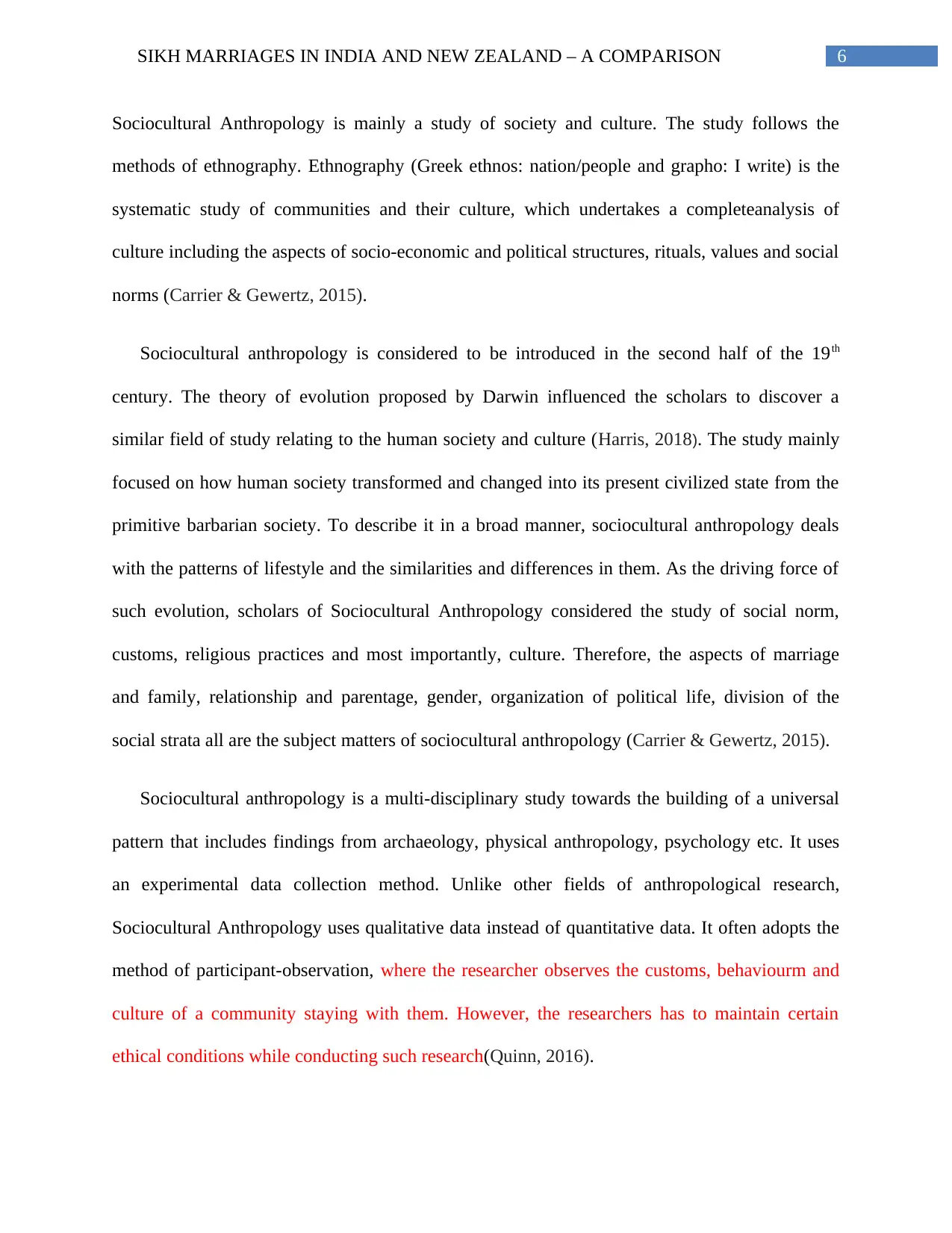
6SIKH MARRIAGES IN INDIA AND NEW ZEALAND – A COMPARISON
Sociocultural Anthropology is mainly a study of society and culture. The study follows the
methods of ethnography. Ethnography (Greek ethnos: nation/people and grapho: I write) is the
systematic study of communities and their culture, which undertakes a completeanalysis of
culture including the aspects of socio-economic and political structures, rituals, values and social
norms (Carrier & Gewertz, 2015).
Sociocultural anthropology is considered to be introduced in the second half of the 19th
century. The theory of evolution proposed by Darwin influenced the scholars to discover a
similar field of study relating to the human society and culture (Harris, 2018). The study mainly
focused on how human society transformed and changed into its present civilized state from the
primitive barbarian society. To describe it in a broad manner, sociocultural anthropology deals
with the patterns of lifestyle and the similarities and differences in them. As the driving force of
such evolution, scholars of Sociocultural Anthropology considered the study of social norm,
customs, religious practices and most importantly, culture. Therefore, the aspects of marriage
and family, relationship and parentage, gender, organization of political life, division of the
social strata all are the subject matters of sociocultural anthropology (Carrier & Gewertz, 2015).
Sociocultural anthropology is a multi-disciplinary study towards the building of a universal
pattern that includes findings from archaeology, physical anthropology, psychology etc. It uses
an experimental data collection method. Unlike other fields of anthropological research,
Sociocultural Anthropology uses qualitative data instead of quantitative data. It often adopts the
method of participant-observation, where the researcher observes the customs, behaviourm and
culture of a community staying with them. However, the researchers has to maintain certain
ethical conditions while conducting such research(Quinn, 2016).
Sociocultural Anthropology is mainly a study of society and culture. The study follows the
methods of ethnography. Ethnography (Greek ethnos: nation/people and grapho: I write) is the
systematic study of communities and their culture, which undertakes a completeanalysis of
culture including the aspects of socio-economic and political structures, rituals, values and social
norms (Carrier & Gewertz, 2015).
Sociocultural anthropology is considered to be introduced in the second half of the 19th
century. The theory of evolution proposed by Darwin influenced the scholars to discover a
similar field of study relating to the human society and culture (Harris, 2018). The study mainly
focused on how human society transformed and changed into its present civilized state from the
primitive barbarian society. To describe it in a broad manner, sociocultural anthropology deals
with the patterns of lifestyle and the similarities and differences in them. As the driving force of
such evolution, scholars of Sociocultural Anthropology considered the study of social norm,
customs, religious practices and most importantly, culture. Therefore, the aspects of marriage
and family, relationship and parentage, gender, organization of political life, division of the
social strata all are the subject matters of sociocultural anthropology (Carrier & Gewertz, 2015).
Sociocultural anthropology is a multi-disciplinary study towards the building of a universal
pattern that includes findings from archaeology, physical anthropology, psychology etc. It uses
an experimental data collection method. Unlike other fields of anthropological research,
Sociocultural Anthropology uses qualitative data instead of quantitative data. It often adopts the
method of participant-observation, where the researcher observes the customs, behaviourm and
culture of a community staying with them. However, the researchers has to maintain certain
ethical conditions while conducting such research(Quinn, 2016).
Paraphrase This Document
Need a fresh take? Get an instant paraphrase of this document with our AI Paraphraser
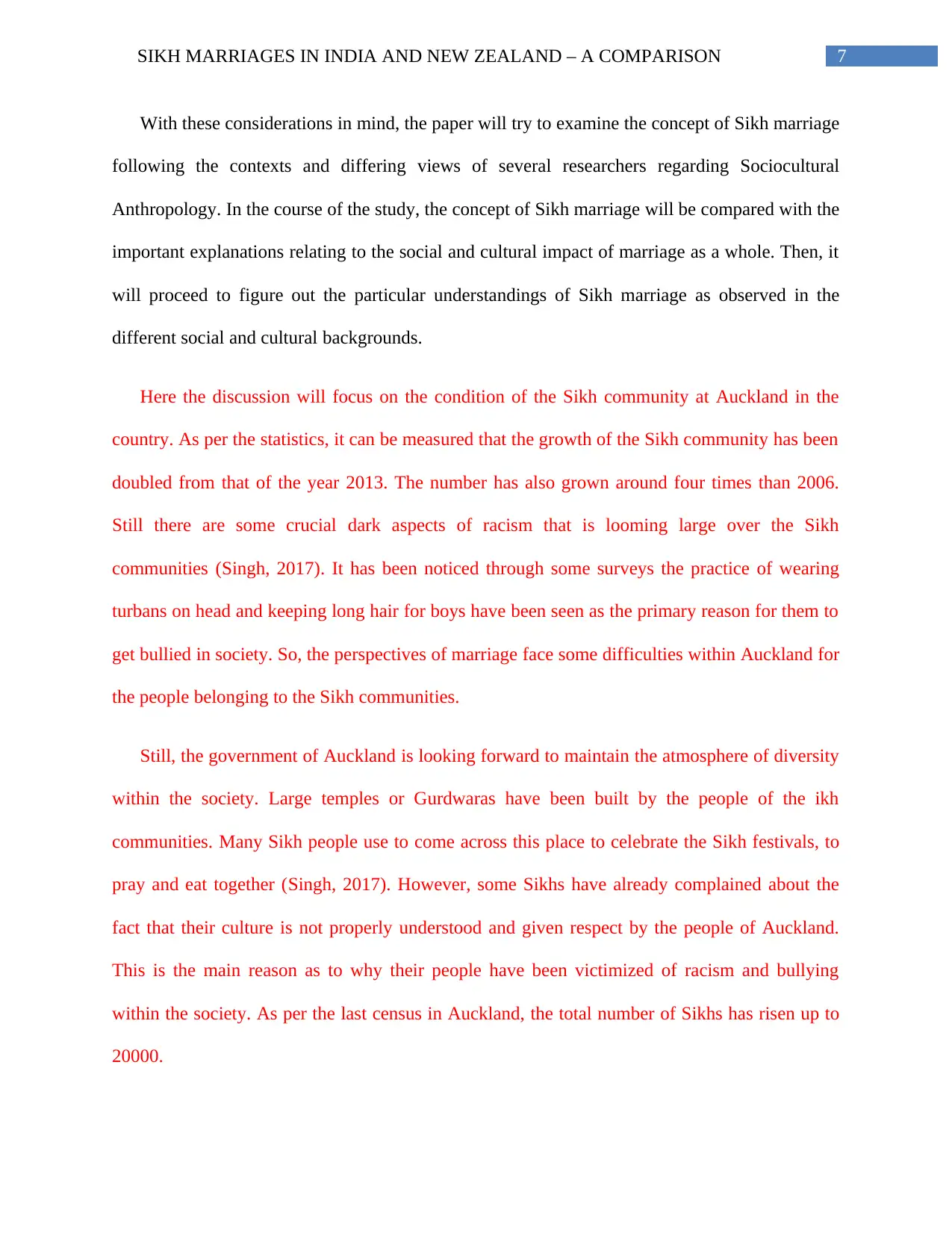
7SIKH MARRIAGES IN INDIA AND NEW ZEALAND – A COMPARISON
With these considerations in mind, the paper will try to examine the concept of Sikh marriage
following the contexts and differing views of several researchers regarding Sociocultural
Anthropology. In the course of the study, the concept of Sikh marriage will be compared with the
important explanations relating to the social and cultural impact of marriage as a whole. Then, it
will proceed to figure out the particular understandings of Sikh marriage as observed in the
different social and cultural backgrounds.
Here the discussion will focus on the condition of the Sikh community at Auckland in the
country. As per the statistics, it can be measured that the growth of the Sikh community has been
doubled from that of the year 2013. The number has also grown around four times than 2006.
Still there are some crucial dark aspects of racism that is looming large over the Sikh
communities (Singh, 2017). It has been noticed through some surveys the practice of wearing
turbans on head and keeping long hair for boys have been seen as the primary reason for them to
get bullied in society. So, the perspectives of marriage face some difficulties within Auckland for
the people belonging to the Sikh communities.
Still, the government of Auckland is looking forward to maintain the atmosphere of diversity
within the society. Large temples or Gurdwaras have been built by the people of the ikh
communities. Many Sikh people use to come across this place to celebrate the Sikh festivals, to
pray and eat together (Singh, 2017). However, some Sikhs have already complained about the
fact that their culture is not properly understood and given respect by the people of Auckland.
This is the main reason as to why their people have been victimized of racism and bullying
within the society. As per the last census in Auckland, the total number of Sikhs has risen up to
20000.
With these considerations in mind, the paper will try to examine the concept of Sikh marriage
following the contexts and differing views of several researchers regarding Sociocultural
Anthropology. In the course of the study, the concept of Sikh marriage will be compared with the
important explanations relating to the social and cultural impact of marriage as a whole. Then, it
will proceed to figure out the particular understandings of Sikh marriage as observed in the
different social and cultural backgrounds.
Here the discussion will focus on the condition of the Sikh community at Auckland in the
country. As per the statistics, it can be measured that the growth of the Sikh community has been
doubled from that of the year 2013. The number has also grown around four times than 2006.
Still there are some crucial dark aspects of racism that is looming large over the Sikh
communities (Singh, 2017). It has been noticed through some surveys the practice of wearing
turbans on head and keeping long hair for boys have been seen as the primary reason for them to
get bullied in society. So, the perspectives of marriage face some difficulties within Auckland for
the people belonging to the Sikh communities.
Still, the government of Auckland is looking forward to maintain the atmosphere of diversity
within the society. Large temples or Gurdwaras have been built by the people of the ikh
communities. Many Sikh people use to come across this place to celebrate the Sikh festivals, to
pray and eat together (Singh, 2017). However, some Sikhs have already complained about the
fact that their culture is not properly understood and given respect by the people of Auckland.
This is the main reason as to why their people have been victimized of racism and bullying
within the society. As per the last census in Auckland, the total number of Sikhs has risen up to
20000.
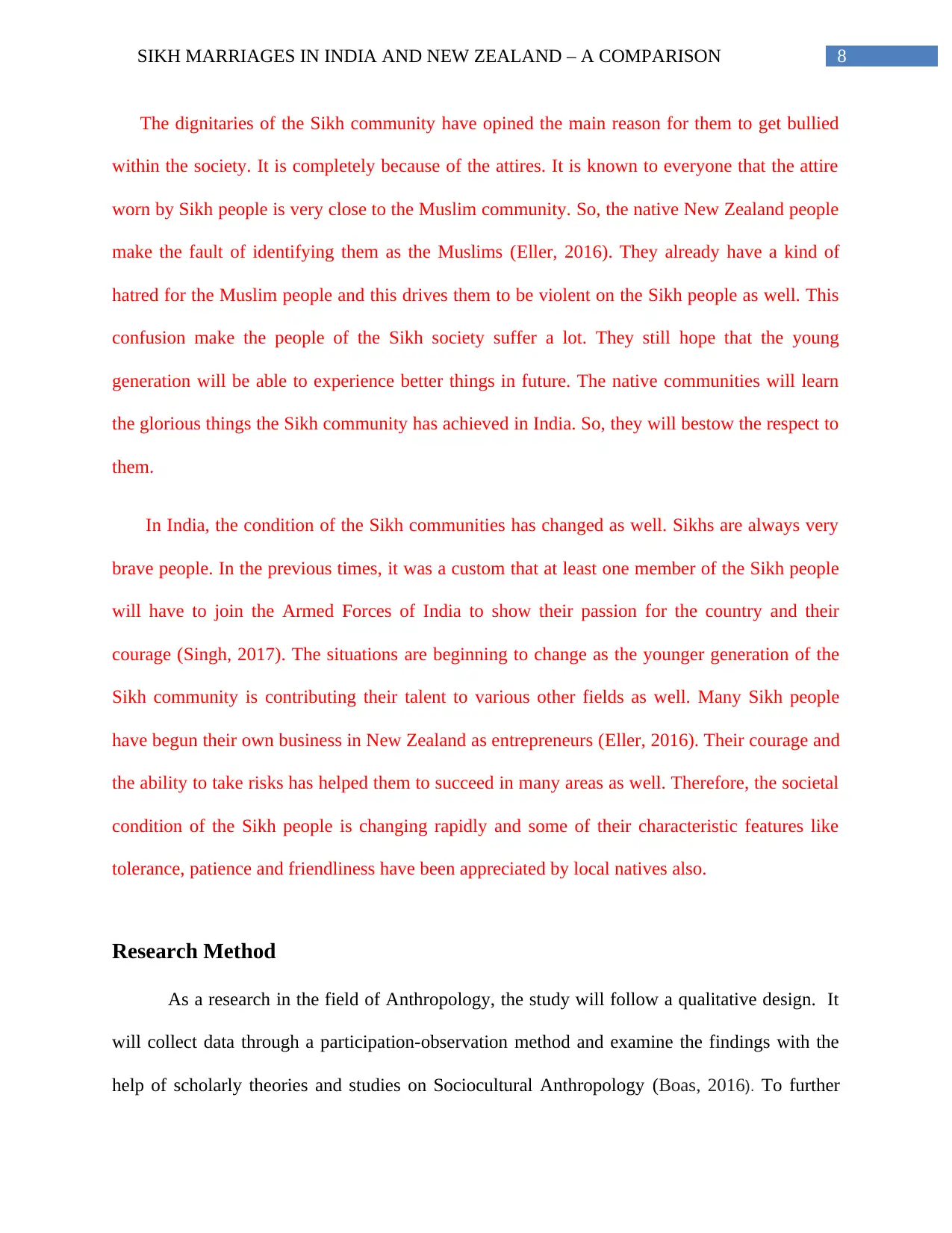
8SIKH MARRIAGES IN INDIA AND NEW ZEALAND – A COMPARISON
The dignitaries of the Sikh community have opined the main reason for them to get bullied
within the society. It is completely because of the attires. It is known to everyone that the attire
worn by Sikh people is very close to the Muslim community. So, the native New Zealand people
make the fault of identifying them as the Muslims (Eller, 2016). They already have a kind of
hatred for the Muslim people and this drives them to be violent on the Sikh people as well. This
confusion make the people of the Sikh society suffer a lot. They still hope that the young
generation will be able to experience better things in future. The native communities will learn
the glorious things the Sikh community has achieved in India. So, they will bestow the respect to
them.
In India, the condition of the Sikh communities has changed as well. Sikhs are always very
brave people. In the previous times, it was a custom that at least one member of the Sikh people
will have to join the Armed Forces of India to show their passion for the country and their
courage (Singh, 2017). The situations are beginning to change as the younger generation of the
Sikh community is contributing their talent to various other fields as well. Many Sikh people
have begun their own business in New Zealand as entrepreneurs (Eller, 2016). Their courage and
the ability to take risks has helped them to succeed in many areas as well. Therefore, the societal
condition of the Sikh people is changing rapidly and some of their characteristic features like
tolerance, patience and friendliness have been appreciated by local natives also.
Research Method
As a research in the field of Anthropology, the study will follow a qualitative design. It
will collect data through a participation-observation method and examine the findings with the
help of scholarly theories and studies on Sociocultural Anthropology (Boas, 2016). To further
The dignitaries of the Sikh community have opined the main reason for them to get bullied
within the society. It is completely because of the attires. It is known to everyone that the attire
worn by Sikh people is very close to the Muslim community. So, the native New Zealand people
make the fault of identifying them as the Muslims (Eller, 2016). They already have a kind of
hatred for the Muslim people and this drives them to be violent on the Sikh people as well. This
confusion make the people of the Sikh society suffer a lot. They still hope that the young
generation will be able to experience better things in future. The native communities will learn
the glorious things the Sikh community has achieved in India. So, they will bestow the respect to
them.
In India, the condition of the Sikh communities has changed as well. Sikhs are always very
brave people. In the previous times, it was a custom that at least one member of the Sikh people
will have to join the Armed Forces of India to show their passion for the country and their
courage (Singh, 2017). The situations are beginning to change as the younger generation of the
Sikh community is contributing their talent to various other fields as well. Many Sikh people
have begun their own business in New Zealand as entrepreneurs (Eller, 2016). Their courage and
the ability to take risks has helped them to succeed in many areas as well. Therefore, the societal
condition of the Sikh people is changing rapidly and some of their characteristic features like
tolerance, patience and friendliness have been appreciated by local natives also.
Research Method
As a research in the field of Anthropology, the study will follow a qualitative design. It
will collect data through a participation-observation method and examine the findings with the
help of scholarly theories and studies on Sociocultural Anthropology (Boas, 2016). To further
⊘ This is a preview!⊘
Do you want full access?
Subscribe today to unlock all pages.

Trusted by 1+ million students worldwide
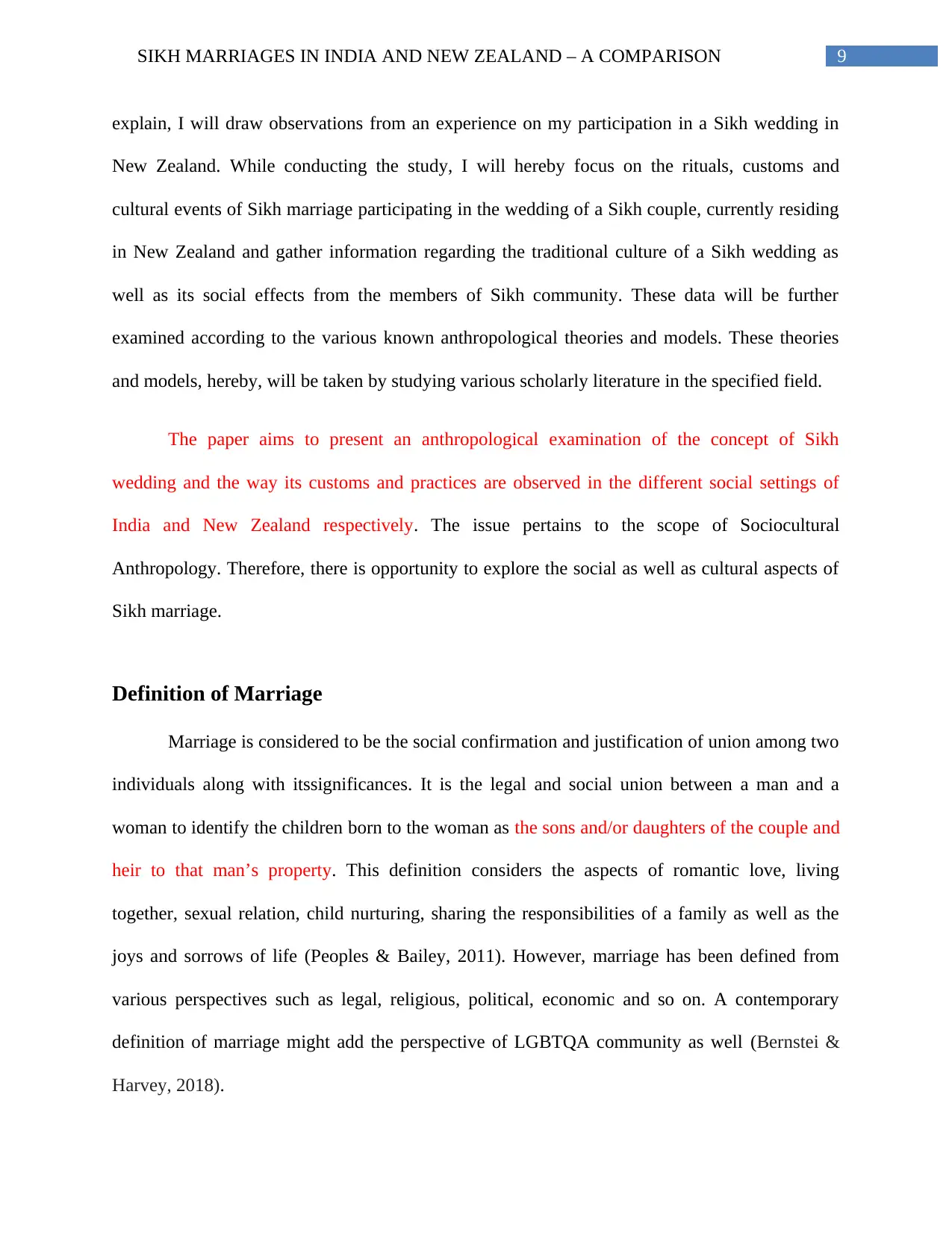
9SIKH MARRIAGES IN INDIA AND NEW ZEALAND – A COMPARISON
explain, I will draw observations from an experience on my participation in a Sikh wedding in
New Zealand. While conducting the study, I will hereby focus on the rituals, customs and
cultural events of Sikh marriage participating in the wedding of a Sikh couple, currently residing
in New Zealand and gather information regarding the traditional culture of a Sikh wedding as
well as its social effects from the members of Sikh community. These data will be further
examined according to the various known anthropological theories and models. These theories
and models, hereby, will be taken by studying various scholarly literature in the specified field.
The paper aims to present an anthropological examination of the concept of Sikh
wedding and the way its customs and practices are observed in the different social settings of
India and New Zealand respectively. The issue pertains to the scope of Sociocultural
Anthropology. Therefore, there is opportunity to explore the social as well as cultural aspects of
Sikh marriage.
Definition of Marriage
Marriage is considered to be the social confirmation and justification of union among two
individuals along with itssignificances. It is the legal and social union between a man and a
woman to identify the children born to the woman as the sons and/or daughters of the couple and
heir to that man’s property. This definition considers the aspects of romantic love, living
together, sexual relation, child nurturing, sharing the responsibilities of a family as well as the
joys and sorrows of life (Peoples & Bailey, 2011). However, marriage has been defined from
various perspectives such as legal, religious, political, economic and so on. A contemporary
definition of marriage might add the perspective of LGBTQA community as well (Bernstei &
Harvey, 2018).
explain, I will draw observations from an experience on my participation in a Sikh wedding in
New Zealand. While conducting the study, I will hereby focus on the rituals, customs and
cultural events of Sikh marriage participating in the wedding of a Sikh couple, currently residing
in New Zealand and gather information regarding the traditional culture of a Sikh wedding as
well as its social effects from the members of Sikh community. These data will be further
examined according to the various known anthropological theories and models. These theories
and models, hereby, will be taken by studying various scholarly literature in the specified field.
The paper aims to present an anthropological examination of the concept of Sikh
wedding and the way its customs and practices are observed in the different social settings of
India and New Zealand respectively. The issue pertains to the scope of Sociocultural
Anthropology. Therefore, there is opportunity to explore the social as well as cultural aspects of
Sikh marriage.
Definition of Marriage
Marriage is considered to be the social confirmation and justification of union among two
individuals along with itssignificances. It is the legal and social union between a man and a
woman to identify the children born to the woman as the sons and/or daughters of the couple and
heir to that man’s property. This definition considers the aspects of romantic love, living
together, sexual relation, child nurturing, sharing the responsibilities of a family as well as the
joys and sorrows of life (Peoples & Bailey, 2011). However, marriage has been defined from
various perspectives such as legal, religious, political, economic and so on. A contemporary
definition of marriage might add the perspective of LGBTQA community as well (Bernstei &
Harvey, 2018).
Paraphrase This Document
Need a fresh take? Get an instant paraphrase of this document with our AI Paraphraser
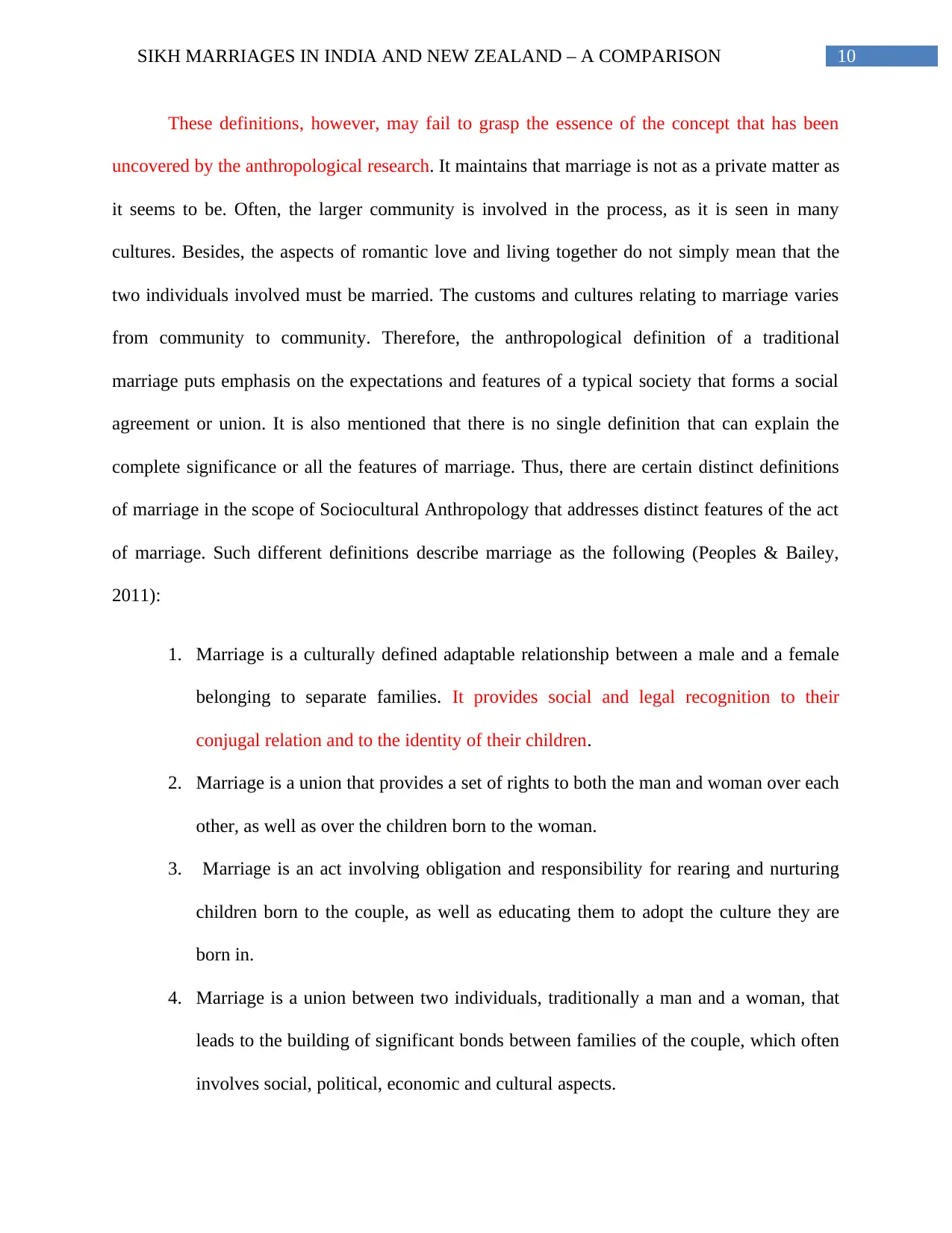
10SIKH MARRIAGES IN INDIA AND NEW ZEALAND – A COMPARISON
These definitions, however, may fail to grasp the essence of the concept that has been
uncovered by the anthropological research. It maintains that marriage is not as a private matter as
it seems to be. Often, the larger community is involved in the process, as it is seen in many
cultures. Besides, the aspects of romantic love and living together do not simply mean that the
two individuals involved must be married. The customs and cultures relating to marriage varies
from community to community. Therefore, the anthropological definition of a traditional
marriage puts emphasis on the expectations and features of a typical society that forms a social
agreement or union. It is also mentioned that there is no single definition that can explain the
complete significance or all the features of marriage. Thus, there are certain distinct definitions
of marriage in the scope of Sociocultural Anthropology that addresses distinct features of the act
of marriage. Such different definitions describe marriage as the following (Peoples & Bailey,
2011):
1. Marriage is a culturally defined adaptable relationship between a male and a female
belonging to separate families. It provides social and legal recognition to their
conjugal relation and to the identity of their children.
2. Marriage is a union that provides a set of rights to both the man and woman over each
other, as well as over the children born to the woman.
3. Marriage is an act involving obligation and responsibility for rearing and nurturing
children born to the couple, as well as educating them to adopt the culture they are
born in.
4. Marriage is a union between two individuals, traditionally a man and a woman, that
leads to the building of significant bonds between families of the couple, which often
involves social, political, economic and cultural aspects.
These definitions, however, may fail to grasp the essence of the concept that has been
uncovered by the anthropological research. It maintains that marriage is not as a private matter as
it seems to be. Often, the larger community is involved in the process, as it is seen in many
cultures. Besides, the aspects of romantic love and living together do not simply mean that the
two individuals involved must be married. The customs and cultures relating to marriage varies
from community to community. Therefore, the anthropological definition of a traditional
marriage puts emphasis on the expectations and features of a typical society that forms a social
agreement or union. It is also mentioned that there is no single definition that can explain the
complete significance or all the features of marriage. Thus, there are certain distinct definitions
of marriage in the scope of Sociocultural Anthropology that addresses distinct features of the act
of marriage. Such different definitions describe marriage as the following (Peoples & Bailey,
2011):
1. Marriage is a culturally defined adaptable relationship between a male and a female
belonging to separate families. It provides social and legal recognition to their
conjugal relation and to the identity of their children.
2. Marriage is a union that provides a set of rights to both the man and woman over each
other, as well as over the children born to the woman.
3. Marriage is an act involving obligation and responsibility for rearing and nurturing
children born to the couple, as well as educating them to adopt the culture they are
born in.
4. Marriage is a union between two individuals, traditionally a man and a woman, that
leads to the building of significant bonds between families of the couple, which often
involves social, political, economic and cultural aspects.
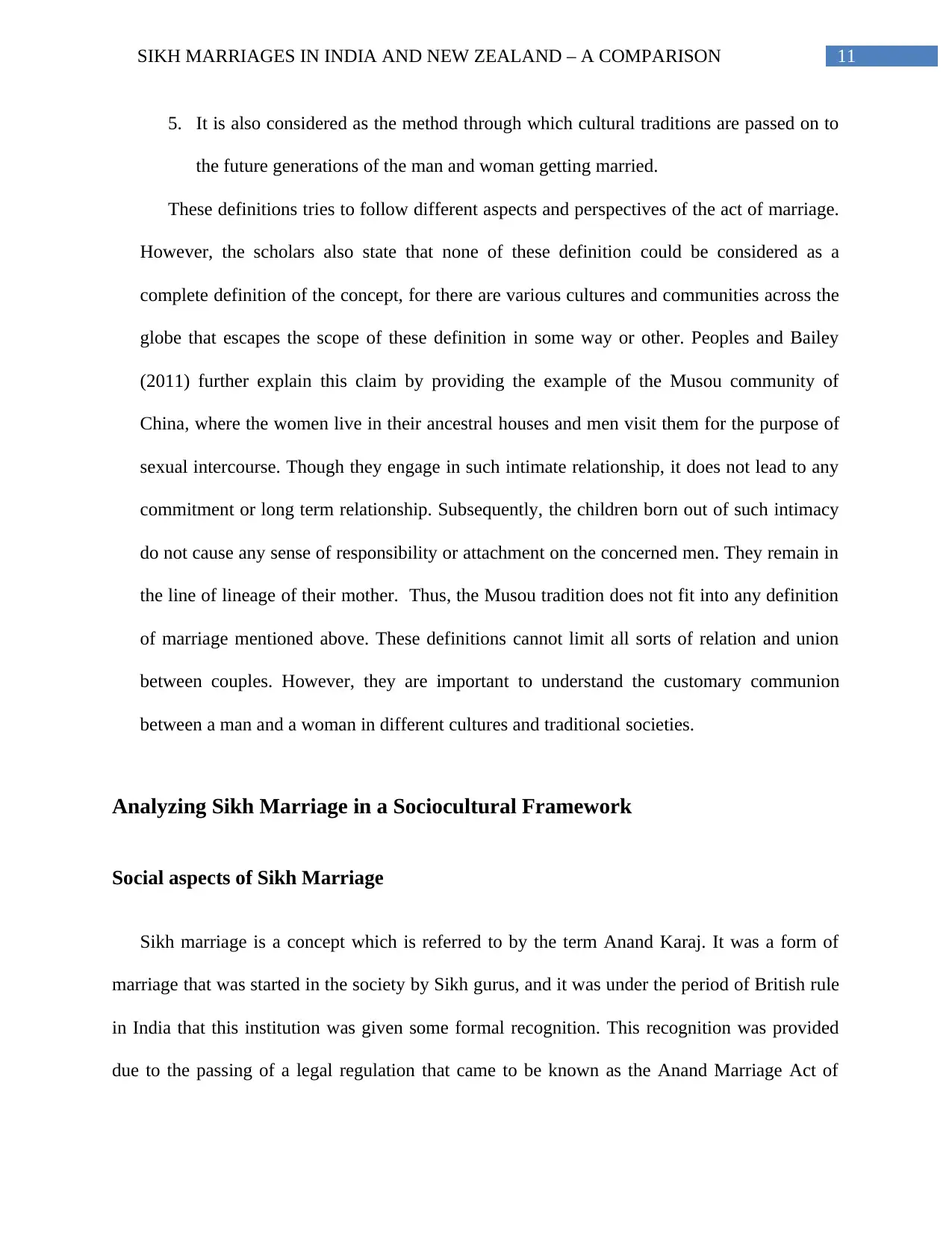
11SIKH MARRIAGES IN INDIA AND NEW ZEALAND – A COMPARISON
5. It is also considered as the method through which cultural traditions are passed on to
the future generations of the man and woman getting married.
These definitions tries to follow different aspects and perspectives of the act of marriage.
However, the scholars also state that none of these definition could be considered as a
complete definition of the concept, for there are various cultures and communities across the
globe that escapes the scope of these definition in some way or other. Peoples and Bailey
(2011) further explain this claim by providing the example of the Musou community of
China, where the women live in their ancestral houses and men visit them for the purpose of
sexual intercourse. Though they engage in such intimate relationship, it does not lead to any
commitment or long term relationship. Subsequently, the children born out of such intimacy
do not cause any sense of responsibility or attachment on the concerned men. They remain in
the line of lineage of their mother. Thus, the Musou tradition does not fit into any definition
of marriage mentioned above. These definitions cannot limit all sorts of relation and union
between couples. However, they are important to understand the customary communion
between a man and a woman in different cultures and traditional societies.
Analyzing Sikh Marriage in a Sociocultural Framework
Social aspects of Sikh Marriage
Sikh marriage is a concept which is referred to by the term Anand Karaj. It was a form of
marriage that was started in the society by Sikh gurus, and it was under the period of British rule
in India that this institution was given some formal recognition. This recognition was provided
due to the passing of a legal regulation that came to be known as the Anand Marriage Act of
5. It is also considered as the method through which cultural traditions are passed on to
the future generations of the man and woman getting married.
These definitions tries to follow different aspects and perspectives of the act of marriage.
However, the scholars also state that none of these definition could be considered as a
complete definition of the concept, for there are various cultures and communities across the
globe that escapes the scope of these definition in some way or other. Peoples and Bailey
(2011) further explain this claim by providing the example of the Musou community of
China, where the women live in their ancestral houses and men visit them for the purpose of
sexual intercourse. Though they engage in such intimate relationship, it does not lead to any
commitment or long term relationship. Subsequently, the children born out of such intimacy
do not cause any sense of responsibility or attachment on the concerned men. They remain in
the line of lineage of their mother. Thus, the Musou tradition does not fit into any definition
of marriage mentioned above. These definitions cannot limit all sorts of relation and union
between couples. However, they are important to understand the customary communion
between a man and a woman in different cultures and traditional societies.
Analyzing Sikh Marriage in a Sociocultural Framework
Social aspects of Sikh Marriage
Sikh marriage is a concept which is referred to by the term Anand Karaj. It was a form of
marriage that was started in the society by Sikh gurus, and it was under the period of British rule
in India that this institution was given some formal recognition. This recognition was provided
due to the passing of a legal regulation that came to be known as the Anand Marriage Act of
⊘ This is a preview!⊘
Do you want full access?
Subscribe today to unlock all pages.

Trusted by 1+ million students worldwide
1 out of 20
Related Documents
Your All-in-One AI-Powered Toolkit for Academic Success.
+13062052269
info@desklib.com
Available 24*7 on WhatsApp / Email
![[object Object]](/_next/static/media/star-bottom.7253800d.svg)
Unlock your academic potential
Copyright © 2020–2025 A2Z Services. All Rights Reserved. Developed and managed by ZUCOL.



